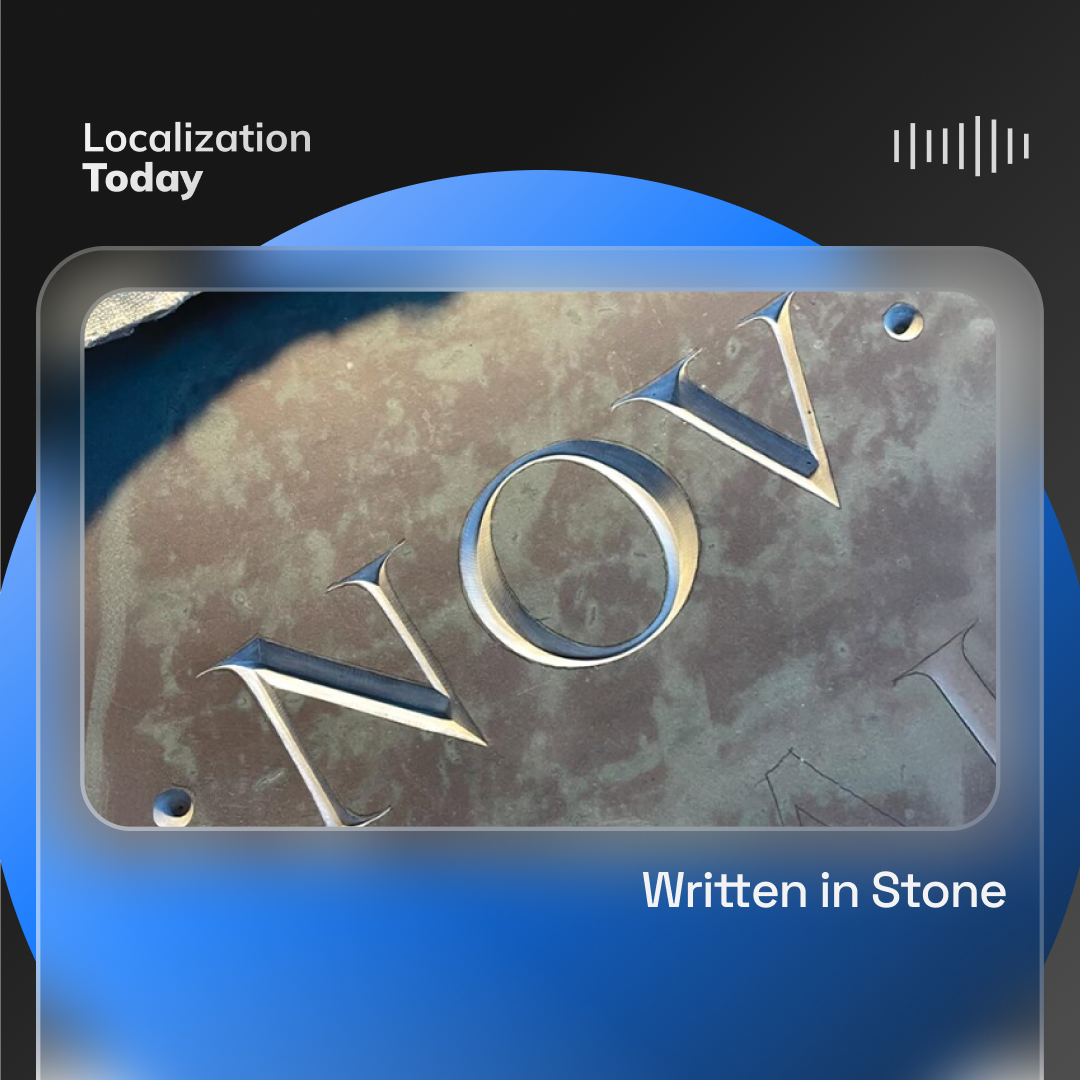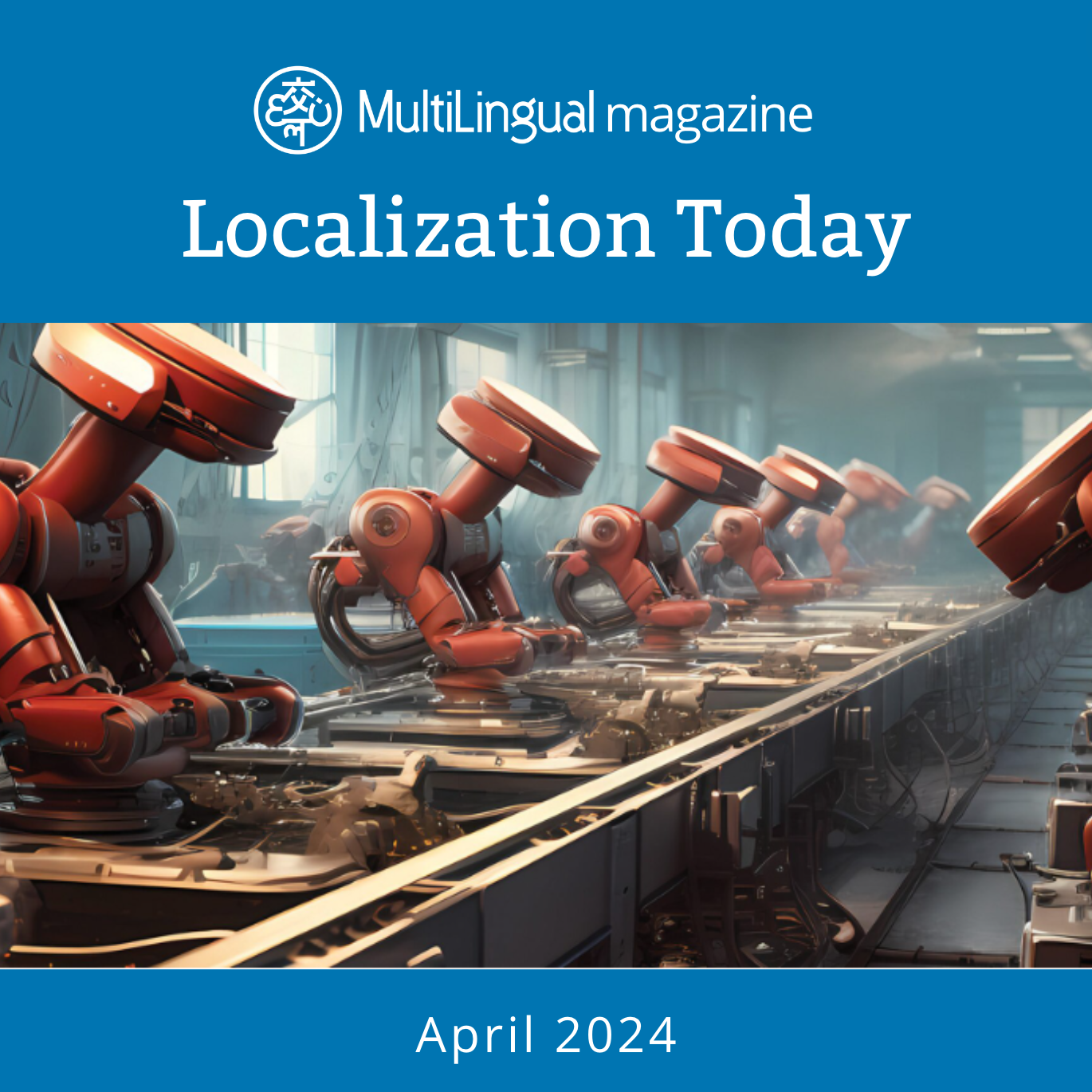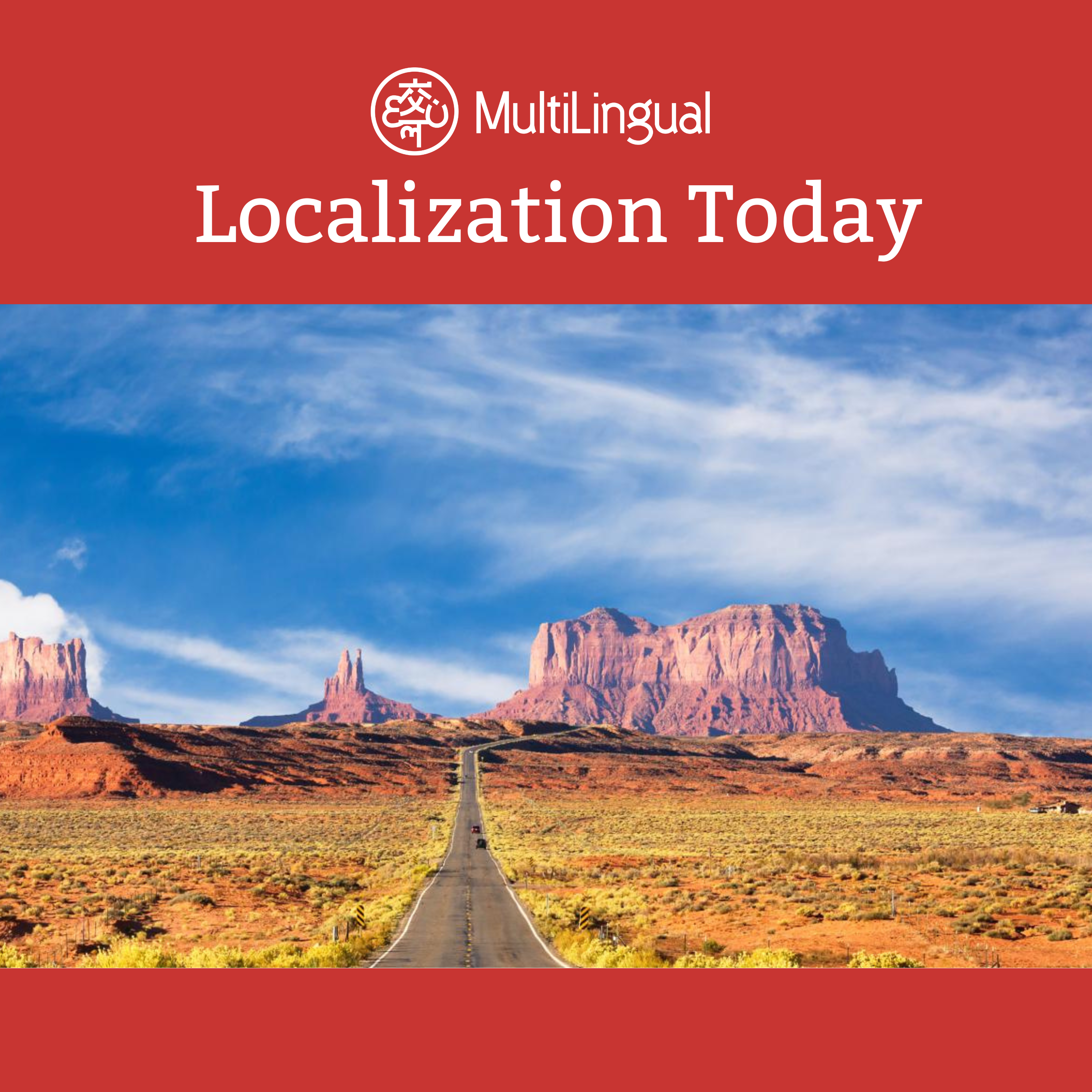Episode Transcript
[00:00:06] Speaker A: This is Localization Today, a podcast from multilingual media covering the most relevant daily news in the language industry.
[00:00:16] Speaker B: Putting globalization strategy into practice an interview with leaders at Emerson by Karen Kuhn and Mimi Hills in the midst of the pandemic in 2021, a small network of localization experts on the client side talked about the strategic insights they had learned from each other. They decided to create a playbook to share their learnings. And so the globalization strategy playbook was born. Cut to early 2023 in the Hague, the Netherlands, where Enos Rubio Sen. Martin was working as director of language services at NI, formerly national Instruments, Enos was leading a recently consolidated group of professionals from the former marketing and product localization teams. After reading the globalization strategy playbook, she enlisted her colleague Sado Koyuta to help refine his globalization strategy by leveraging data analytics. Now, a year later, and despite Emersons acquisition of NI, the project is in full swing. We interviewed Ines and Satoko to find out how its going and what theyve learned about creating and implementing a data driven globalization strategy.
[00:01:24] Speaker C: Getting started Karen Koum what did Ni's.
[00:01:28] Speaker A: Globalization strategy look like before you read the globalization strategy playbook?
[00:01:33] Speaker C: Ines Rubio San Martin the marketing and product localization teams had been separated for a long time because they were created out of different needs and visions.
Product localization was at NIS headquarters, and marketing translators were part of regional marketing teams, plus, customer facing operations and support teams translated content daily as part of interactions with global customers. This organic approach worked fine for many years as NI expanded internationally. For example, if the japanese branch felt like it needed more translations to serve its market better, it would just go ahead and do it. However, the teams duplicated efforts and even created inconsistencies in language experience across the customer journey. There was no shared understanding of what a centralized language strategy could bring to NI.
As NI reached the next level of maturity and pursued efficiency and scalability, the benefits of merging the teams became obvious to company leaders, who were compelled to align their vision. It became evident that localization isnt merely a peripheral task, but a specialized field requiring investment for effective execution.
Thats when the centralized language services team was formed, empowering us to drive company wide language strategy conversations.
[00:02:55] Speaker A: How did you discover the globalization strategy playbook and how did you start implementing the advice, suggestions, and principles that it covers?
[00:03:03] Speaker C: We discovered the playbook while researching conferences to attend last year. I think it was linked in the program description of Lockworld.
I couldnt believe we didnt know this content had been so generously shared a year or two prior I read the book in less than 48 hours, highlighting areas that both confirmed the things that we were doing right and that suggested there were opportunities for improvement in our process or strategy. Based on the playbook, I came up with a list of action items for the team.
Then I distributed a backlog of items to research or consider among the different leaders.
Last year, we prioritized gathering the data and shaping language strategy around it. It was our top priority because we lacked expertise in that area and the gap was pretty evident. But after going through the entire playbook, we picked other tasks to tackle as well.
[00:03:58] Speaker D: Mimi Hills why did you choose Satoko to lead the data analytics side?
[00:04:03] Speaker C: Satoko has been with the company for 20 years and led the Asia Pacific localization team for over a decade. Shes an electrical engineer by training and is very familiar with our products and how the different groups collaborate.
She has a very diverse skill set and background which made her the perfect match to move into this dedicated role.
Moreover, we required someone skilled in working with numbers, someone who pays close attention to details. Satoko is extremely meticulous.
I have a very different personality.
I bring a clear vision at a high level.
I know where I want to go and I surround myself with folks that will contribute to figuring out step by step how to get there and how to measure progress.
I think thats why we work together very well.
Sure enough, Satoko hit the ground running with analytical questioning. She quickly grasped the objectives and prompted productive discussions that led to a clear definition of our yearly goals.
Then she completed formal training in data analytics in record time.
[00:05:11] Speaker D: How did you decide which data to gather and how to analyze it?
[00:05:16] Speaker C: I would tell I dont know why were localizing this product and not this other one. We would agree on how to measure the prioritization and then she would know exactly where to extract the right data points from. She understands how to make an impact and how to adapt messaging to different audiences, and she uses tools like Microsoft Power Bi to manage data and present insights effectively.
Once she gathered the needed data, she would ask questions such as how do we want to organize this data?
Do we want to split it by region or by language? That would push me to define my tasks and challenge assumptions.
Once she defines the insights we will need in the future, she automates both the data collection and data visualization for efficiency and easy reference. Another wonderful thing she does.
[00:06:06] Speaker D: Satoko, how would you describe your role in the department?
Which parts of the globalization strategy playbook helped you the most?
[00:06:15] Speaker E: Satoko Yuda my responsibilities include data analytics which consist of data gathering, maintenance and visualization by cross analyzing the data, the key performance indicators, KPI's, and the language strategy decision framework created last year. I help management make holistic decisions by providing return on investment and by sharing my recommendations based on my insights and findings, chapters four and six of the playbook covered language strategy and data analytics. They provided a clear idea of the industry best practices and helped me identify.
[00:06:55] Speaker B: Gaps and opportunities, insights and changes based.
[00:07:00] Speaker D: On your data analysis, how are you updating your globalization strategy?
[00:07:05] Speaker E: We are revising our language tiers which will affect the support level for some languages and content types. We realized certain languages cost to revenue ratio is quite high in comparison with others in the same tier. When we analyzed the gathered data last year, we would like to move some of the tier one languages to tier two, proposing a lower level of support.
[00:07:28] Speaker A: Do you have a desired proportion of costs to revenue? Like cost should be 5% of revenue or revenue should be ten times the cost?
[00:07:35] Speaker E: We don't have one yet, but we are building the historic data for it. We have a prioritization framework that we can use for now and we have a good idea about what products we should be supporting for each language.
[00:07:49] Speaker A: I don't think there's any real industry standard for that either, but this is what we need.
[00:07:54] Speaker E: You know, the percentage should go down as the products maturity goes up, but some of our products haven't reached that point yet. That's why we're gathering historic data to understand the trend. We are also trying to understand local market needs better so that we will be able to support them.
[00:08:13] Speaker A: Can you say anything about some of the KPI's that you decided upon?
[00:08:17] Speaker E: We are looking at cost per word and cost to revenue ratio. We are looking at revenue by country and by product support. Deflection is another one.
[00:08:28] Speaker D: Are you able to measure that?
[00:08:29] Speaker E: Translation helps customer support by enabling self service of information and avoiding unnecessary calls and email traffic. Traditionally, we enabled this deflection by publishing information in forums, guides and frequently asked questions faqs online today, some of our new technology implementations include fully automated useful translation without human involvement. We're switching from human translation to machine translation for certain content. This allows us to provide a better service to our customers without increasing pressure on the service teams.
[00:09:10] Speaker A: Regarding revenue and looking at cost versus revenue. Is it easy for you to see revenue by product, by language, or do you have to look at everything thats sold in France and see what that revenue is?
Is that information broken down for you in a simple way in your financial system?
[00:09:26] Speaker E: We can easily pull the revenue for any country, what is harder to get is the rate of adoption of localized products by our customers. For example, for our major product called Labview, what percentage of the customers in France are using the localized version as opposed to the english version? We don't have this type of data yet. This is one of the areas I will be working on this year by collaborating with stakeholders to get telemetry. We need more data on localized product usage in general. What I have found so far is that many datasets do not have both language and country information. To understand the utilization of the localized products in a country, both data fields are important to make holistic decisions. Having just one of these parameters will not give us the whole picture.
[00:10:17] Speaker A: Are you looking at products and content that are accessed online?
Are they downloaded or are they page views?
[00:10:23] Speaker E: I'm trying to get the number of downloads and license activations of the localized version versus the english version. These data are partially available, but data fields used in a data set vary based on products.
Therefore, it is currently challenging to get consistent data across all localized products. I am working on requesting the necessary data fields. The goal is to get consistent data across all products that include both country and language data fields.
[00:10:54] Speaker B: Working with stakeholders how did you go.
[00:10:58] Speaker A: About getting stakeholder buy in for the updated language strategy?
[00:11:01] Speaker C: Satoko did a wonderful job last year tidying up our language strategy to make it easier to understand for others in the company.
For example, we highlight the details of the metrics used to measure the success of our program.
One such metric is the ratio of the language services program cost to company revenue in the regions supported with translations, among other parameters. We consider customer satisfaction measured by our CSAT survey using loyalty as a metric, and we also consider support deflection data. These success criteria are tightly aligned with company goals. Weve taken two actions that impact our stakeholders. One, we started challenging new requests when the requester could not justify the investment to ensure data driven prioritization and two, we are rethinking what languages to support and the scope of our support through a redefinition of language tiers. Previously, the project management team was prioritizing work with available data, requesting ROI information from stakeholders for larger new requests.
Satulco took over this work at the end of 2023, equipped with a deep understanding of the current localization investment map and priorities.
As for the revision of the tiering system, we are working through the misalignments that Satoko discovered, and although we expect some pushback from the stakeholders of the language affected, we believe we should keep moving in this direction.
However, it is still too early to know.
I believe the right data will convince content owners and requesters that we are making the right decisions, considering that we are all focusing on efficiency and investing in the right places, a language services team that presents itself as a strategic partner with strong expertise on what serves our customers should be a reassuring interaction for our internal stakeholders.
[00:12:54] Speaker E: What is the most challenging part of communicating your vision to stakeholders?
[00:12:59] Speaker C: Because it is common for localization teams to be part of the research and development or marketing teams and not to operate at the enterprise strategic level, one thing I always find challenging is to approach teams outside of our department to propose either the revision of their language strategy or the adoption of language technologies.
Building the right connections providing leaders with insights into our teams capabilities and making them more open to working with us is a never ending task, particularly through company or leadership changes.
I believe we are better equipped to have these conversations now, but the organizational changes derived from the acquisition will require us to restart the evangelization process with some teams.
[00:13:43] Speaker E: The acquisition when Emerson acquired NI at.
[00:13:47] Speaker A: The end of 2023, in the midst of your building out the analytics, you became Emersons Test and measurement business group. How did that affect the project?
[00:13:57] Speaker C: The changes in leadership resulting from Emersons acquisition prompted a thorough review of organizational structures.
The previous leadership team, which was aware and supportive of our efforts, had transitioned out of the company, so we had to recommence our efforts to share our work and results with leadership.
We provided an overview of our program evolution and modernization efforts, which was praised as exemplary. While restarting our work may seem like a setback, were able to progress more rapidly this time around due to the availability of comprehensive data and valuable insights.
[00:14:34] Speaker D: What are the synergies in the products and services between the larger company and the test and measurement business group?
[00:14:40] Speaker C: Currently, weve been instructed to focus on the research for efficiency multipliers inside our own program instead of enterprise level synergies, I believe this approach aligns with Emersons way of operating where after acquisitions to diversify their portfolio, the company grants a considerable degree of autonomy to new business groups. We are in touch with Emersons Enterprise translation team, which is responsible mainly for their website localization.
We appreciate their proactive approach to exchanging information about program differences and best practices.
We have different philosophies and understand that both approaches to localization have their benefits and challenges, but that begs the when one company acquires another, how do you deal with the stakeholders? How do you analyze the ongoing localization?
When do you just leave it as it is, as Emerson has done with our teams so far and when do you want to look for synergies?
Maybe that's the next level that you haven't covered in the playbook.
[00:15:44] Speaker D: Those are interesting topics. You might have to contribute a chapter to the playbook.
[00:15:50] Speaker B: Lessons learned and future goals what did.
[00:15:53] Speaker A: You personally learn from this whole process?
[00:15:56] Speaker E: In the data analytics area, ive learned to understand what data is crucial for decision making and how to ensure its relevance and effectiveness. This allowed us to transform complex information into actionable insights and to not only monitor KPI's effectively, but also interpret their significance in driving strategic decisions. Another area of learning was developing a language strategy decision framework. We started from the localization efficiency framework presented by Marco and Eiji Wang during Lockworld 43 and expanded the framework to fit our needs.
[00:16:34] Speaker C: I have grown more confident when presenting about the program or proposing future innovations.
Solid data that supports my vision is a game changer. There are no efficiency or cost surprises.
We understand well the challenges we face, the areas where we are over investing, and the changes needed.
Also, when announcing huge accomplishments, you need reliable data to back you up. It takes a lot of confidence to publicize that our team has multiplied capacity x ten and reduced the cost of the program by 25% in the last five years.
[00:17:10] Speaker A: What are some of your goals for this year and beyond?
[00:17:13] Speaker C: We havent done a proper audit of our technology yet and we dont have our OI cases for all the technology were using, so thats work for 2024.
J. Liu is spearheading this effort as our head of technology.
[00:17:28] Speaker E: We are hoping to merge our scattered, homegrown and off the shelf solutions into one translation management system this year. The challenges are numerous, especially maintaining leverage of translation memories while pivoting from one system to the other. Additionally, we looked into a software globalization readiness and found new brand software development to be too english centric and focused on delivering a working product in English. We believe internationalization should be part of the development cycle and we are pushing for internationalization to happen at a much earlier stage of development to make localization less costly and more effective. We would like to work with R and D stakeholders to evangelize this need, but the change is not coming this year. It takes time.
[00:18:19] Speaker B: This article was written by Karen Kuhn, retired from the localization leadership role at PDC after 20 years, and is currently teaching the localization management class at the localization institute and Mimi Hills. She teaches the localization teams masterclass at the localization institute and has led globalization teams at major companies in Silicon Valley.
Originally published in multilingual magazine, issue 227 April 2024 thank you for listening to localization today.
[00:18:53] Speaker A: To subscribe to multilingual magazine, go to multilingual.com subscribe.


